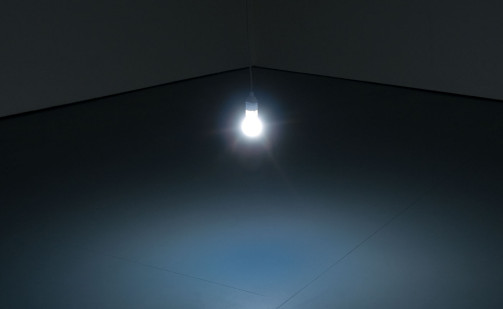
Katie Paterson, ‘Lightbulb to Simulate Moonlight’, Haunch of Venison Gallery, London.
“This house is far away, it is lost, we inhabit it no more; we are, alas, certain of inhabiting it never again. It is however, more than a memory. It is a house of dreams, our oneiric house.”
Gaston Bachelard
“Important works of art are the ones that aim for an extreme; they are destroyed in the process and their broken outlines survive as ciphers of a supreme, unnameable truth.”
Adorno, Sacred Fragment,
Schoenberg’s Moses and Aron
I want to write about aesthetics more, because I think often there is such a huge neglected political aspect to this topic, and because far more than pure political science, or left dissident criticism, hardly anything is really written about it. When I started this blog, my intention was to write a good deal more about the practice of writing, and the poetics of theatre, of film, and painting. But it’s been increasingly difficult to separate these topics. Adorno wrote about the state of aesthetics fifty years ago: “This abstract and largely mechanical derivation of aesthetics from pre-given philosophies seems to me to be the essential reason for the fall of theoretical aesthetics.” As Andrew Bowie cogently put it, “…if philosophy cannot learn from art, and if its job is just to tell us the truth about art in the same way it does other issues, then ultimately we wont need art anyway.” But I believe we do need art, and rather desperately. In an age of instrumental logic, of almost cultic worship of science, of a science mediated by political forces, society will completely lose touch with how to narrative our lives to each other and to ourselves, and will increasingly forget how to engage with the impulse to create, and will suffer the further deterioration of our imagination.
But, I happened this week to go out to the cinema. I was with my wife. There was not much showing, so we decided, well, Dawn of the Planet of the Apes is likely better than Hercules. I think perhaps five minutes into this film our heads turned simultaneously and we looked at each other. It was horrifying. Not just was it infantile, for that almost goes without saying. No, it was worse. And it was worse in ways that I think I need to approach in a very roundabout fashion.
One cannot talk aesthetics without bringing in Adorno. Not today. You can’t. And like so many seminal thinkers, there is a lot of mis-reading of Adorno, reductive reading. And in a sense, this is predictable because he is very difficult. And I have had arguments going back years and years with people about how to read him. But for the purposes to today, I want to start with something I’ve not written about, but which I have taught a good deal, and that is writing for the theatre.

Youssef Nabil, photography. Cairo 1997.
A man walks into a room. Another man sits there. The first man says “Do you have a banana, I’m hungry”.
The second man says, “No, why would I have a banana, get the fuck out of here”.
Thats the worst version.
Second version:
A man walks into a room. Another man sits there. The first man says “Do you have a banana, I’m hungry”
The second man says nothing. The first man finally leaves.
That’s a bit better.
Third version:
A man walks into a room. Another man sits there. The SECOND man says “No, I have no banana, why would I have a banana. Get the fuck out of here.”
That’s the best version. Why? Well, version #1 is obvious, rational and without mystery. Version #2 at least leaves us with an unanswered question. There is a question raised. Tension. Version #3 however is best because someone is answering unasked questions. And by so doing a huge leap takes place. One has bypassed the usual asking of questions which can be answered, and are often answered because of visual evidence. One has skipped the asking when the question is not answered. And one has gone straight to an assumption of previous questions, and suddenly there are several layers of history both revealed and obscured. I think that Pinter probably grasped this better than anyone. It was his primary genius in fact.
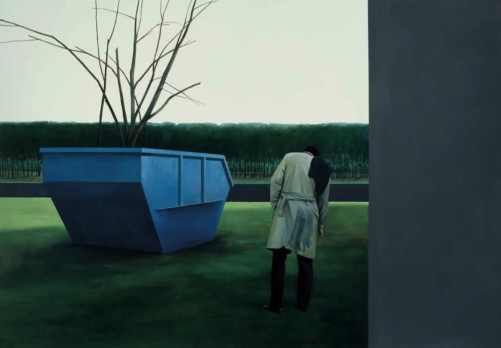
Tim Eitel
I have spoken a lot about the uncanny. And it is because I think the uncanny is directly linked to mimesis and the non-identical. The uncanny is at work whenever something isn’t answered. Or rather, it is there if the question is legitimate. The above painting by Tim Eitel is, I think, a good(ish) painting. It is not a great painting. It want’s to be uncanny…but I am not sure it is. Eitel is a very talented painter. He studied in Germany, and now lives in Paris. He works from photographs. In a sense, Eitel is doing his own version of the Chiat Day syndrome, albeit doing it very well, and with enough intelligence to offset some of the self conscious “uncanny”ness. This particular painting could be a poster for Songs From the Second Floor, for example.
Jameson said, speaking of Adorno:
“Yet the form of the sentences must now also be seen as a form of philosophizing in its own right.”
Part of Eitel’s problem is that he is not technically convincing. Not enough. It is as if the painter’s tecnique is akin to the actor for the playwright. Better technique, say that of Borremans, and a qualitative change takes place. Not even Beckett could stand up under Steve Martin and Robin Williams. The paintings of another young German, Stefan Kurten, are far more unsettling. Kurten works often with gold pigment, and he paints more architecture than Eitel, and indeed is doing something rather different. But for now, I post one of his paintings, below.

Stefan Kurten
This is a disquieting painting because it seems to about something idyllic, and yet the sky is wrong, there is an indeterminate light, and then that gold. The gold is just unnerving. The painting is answering questions unasked, if one wants to push that model. It is imposing something on the viewer, much as a real estage agent might. The viewer is being pressured. In Eitel, by contrast, there is something just the tiniest big smug. Comfortable. And again, I do think Eitel is a decent artist.
But to return to Adorno, and to Jameson, one of the problems with the culture industry is that is now so effectively assimilates all rebellion. All attempts to create radical vision is quickly (as Jameson puts it) ‘registered’ and catalogued and made into a ‘style’. The style is then marketed in mass. This however is mediated to a degree by genre. And one of the potential escape valves for co-option is genre. Genre is already a registered style in a sense. The radical ‘western’ is still a western. The accommodation can only partly take place with any particular work because there is this prevailing category of genre. The best genre work today, in film anyway, are those that work off of subtraction. They simplify, and remove as a strategy. There is more to say on that, but for now..there is another aspect running alongside this, and that is the economic. The corporate interests eliminate the independent economic subject. The artist is bought out whether he or she wants to be or not. Jameson suggests that a kind of fetishism is the only possible result of the Utopian impulse.

Elio Ciol, photography. ‘Mongolia’
In Pinter’s The Caretaker, the triangular dialogue in Act 2 is a constant repetition of unfinished conversation, but it ends with, as Pinter often did, a long(ish) monologue by ‘Aston’. For all this elliptical dialogue must find a way to be recuperated. The monologue does nothing to resolve the plot, if one can say there even is a plot. But what it does is restore the sense of legitimacy to the scene. Memory may be faulty, Pinter makes clear, but that is how we re-form our lives in the end.
Because there is nothing resolved, the audience is left with an uncanny and disturbing, or haunting sense of their own memory of the play just witnessed. Jameson (discussing Adorno) says only when a subject enters the force field of late capitalism does the mimetic occur, that it is a relationship between private property and personal identity. That the mechanisms of Capital, of property, of instrumental logic all serve to diminish the subject, or his inner life anyway.
Adorno says, in Minima Moralia: “…the will to live finds itself dependent on the denial of the will to live…”. This is not as simple as man-as-robot, however. For it is dialectical. The forces of advanced Capital, monopoly capital, are all in the service of standardization, and this encroaches on, in fact it is foundational, subjectivity. We think in the language of monopoly, and of Corporate restrictions, we think in terms today, of financialization.
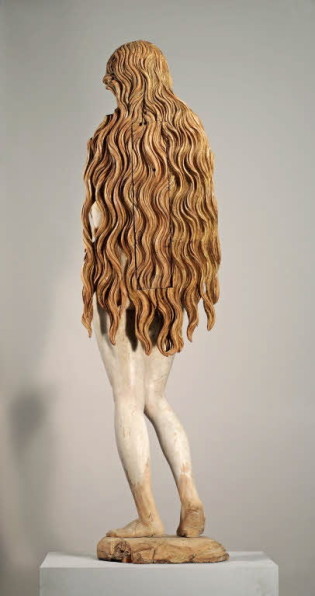
Gregor Erhart, 1520 AD
This discussion at this point turns to the ideas of the ‘Culture Industry’; the most well known term, probably, in all of Adorno’s works. And one that has always met with resistance by the American public, and in U.S. academia. In spite of, or perhaps because of, the rise of marketing as a science in the U.S., and because of the deep Puritan sediments layered beneath the business friendly Anglo-Protestant values system, the very idea of manipulation was countered by a kind of manufactured populism. This populist trend was also (and is also) married to the American resistance to class analysis. Now, Jameson points out that Modernism by the 1950s was hegemonic in U.S. academia. And this is true, but it’s also not true. For there was a hidden class bias operative in this throughout.
There has also been the emphasis, in this new populism, on amusement, or even pleasure. And here is where a deeper analysis is called for. Kitsch, the products of mass culture, do not provide pleasure. They provide some kind of enjoyment, perhaps (there is a whole discussion, obviously, to be had on the nature of pleasure and links to sexuality). But one of Adorno’s crucial points was the austerity, even monasticism, of genuine engagement with culture and art. As he said: “In the Culture Industry, jovial renunciation takes the place of pain that lies at the heart of ecstasy and asceticism alike.”
It is the ideology of intellectual pacification that runs through all mass culture that must be resisted.
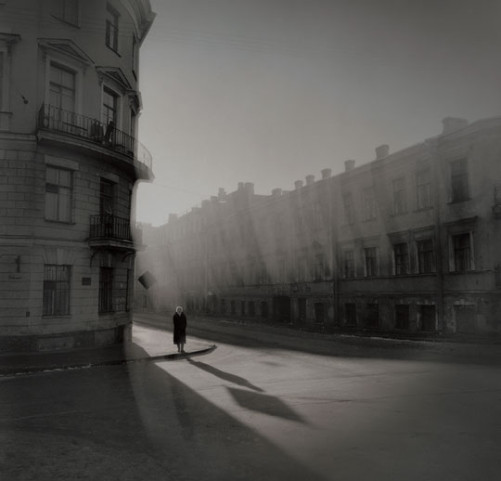
Alexey Viktorovich Titarenko, photography.
But back to the uncanny.
“This recalls Freud’s dictum that the uncanny is uncanny only because it is secretly all too familiar, which is why it is repressed.”
Adorno, Aesthetic Theory
For Adorno (per Jameson) there is an active hatred of art by those whom is excludes, and because of this resentment the excluded demand validation for mass cultural amusements, and further, those who even grasp all this but reject the sacrifice of denying a shallow momentary happiness in lieu of that deeper spiritual regeneration of society itself. In a sense, this is the position of a fascist mentality.
Freud wrote, on the uncanny; “Yet we expect that a special core of feeling is present which justifies the use of a special conceptual term. One is curious to know what this common core is which allows us to distinguish as ‘uncanny’ certain things that lie within the field of what is frightening.” Anthony Vidier points out that ‘uncanny’ is extremely difficult to pin down, and hence finds itself translated in an unusual ways in various languages. Sinistre, etrange, de mal aguero, lugubre, etc. But in non of these languages is uncanny directly synonymous with fear or terror. Nor with the grotesque, or disfigured. It is too close in conceptual structure to things which are familiar. In German of course it is unheimlich, and the English uncanny is derived from ken, or beyond knowing. The canniness part is simply skill. But it is in German that the deepest resonance occurs. For the uncanny is always linked to home. And home is always linked to exile, to homelessness, and to memory. The uncanny is the deep memory of a lost home. And the experience of the uncanny reminds us of that lost home, the one to which we feel guilt for having forgotten. Certain colors are associated with the uncanny, amber for one. Amber light is the direct expression of that petrified sap in which is lodged lost life, and lost memory.
This is what the Frankfurt School, as a whole, saw in their critique of anti semitism. It is a class analysis, for everyone is promised happiness, and that is what Adorno came to call the *broken promise*. One cannot have real happiness until everyone can have real happiness. This is why art and culture have such marked political significance. Now in the United States, historically, the resentment has been directed most acutely at those whose ancestors were slaves. Black culture is the most potent expression of genuine happiness that it’s possible to find, and it accounts for the dramatic efforts of the ruling classes to commodify, neutralize, and destroy it.

Lassse Lecklin, photography. Iceland.
The uncanny is connected to a term I’m going to invent, ‘deep memory’. Because the familiarity of the uncanny image is not a familiarity one can access. One cannot sit and concentrate and try-to-remember. Now, it is possible that this is simply the repressed material of childhood. And likely a good portion of it is. But I suspect it is more than that, and it is that part of repressed material that interests me the most, and which I think artists make use of, and to which I believe culture is linked.
There are probably two levels of uncanny. The Pinter play mentioned above, operates on the lesser uncanny level. The play itself is a masterpiece, but the uncanny is tied to the mimetic re-narration of the play itself. The audience is questioning his own experience of spoken text, and there is an examination given on ‘listening’. The uncanny resides therefore in a brief temporal space, even if the deeper layers of meaning continue. There is in the deeper uncanny something that is allied to the tragic. A work may be deeply uncanny and not be tragedy, but it will bleed into the tragic impulse to some degree almost always. The German Romantics were often deeply uncanny, and Von Kleist might be the culmination of this branch. His essay on marionettes remains an indispensable text for understanding the links to myth and Dionysian mystery, the uncanny as revelation. The uncanny is always, on both levels, a mystery. This is why narrative that opens us to the experience of something uncanny is always a story of crime, or primal crime. Architecture is often uncanny, and for reasons similar to tragedy. The sense of our forgotten homes is evoked very acutely in certain buildings. Piranesi’s Carceri are exercises in deep uncanny. Kafka, of course, is the modern giant of the deep uncanny. There is an spatial aspect to the uncanny, and it is partly linked to vertigo. John Martin wrote of Pirinesi, that one always feels as if measuring these spaces from on high. It’s not a rational response, but then this is where guilt begins, and this is also partly an aspect of the *broken promise* We desire to remember where our exile began, but we cannot, and there is a feeling of betrayal attached to this. For it is not only ‘my’ forgotten exile, it is ‘our’ forgotten exile. To get to the forgotten past is akin to navigating a maze, and here that quality of claustrophobia common to the uncanny becomes another artery of the forgotten, of the irretrievable.

Ziad Antar, photography.
Tied into this discussion is the theme of the passing of modernism. Whether that dissipating of energy turned into something called post-modernism, I’m not sure, but probably I fail to see what post modernism actually is. For it seems to be more about what it is not. It is not epitaph, but simply caesura. The pause before the Fall. Everyone today lives in the shadow of transnational corporate business. For this vast realm of devouring insensate destruction not only destroys people, and landscapes, but it eats the inner life of those it leaves alive, and its most malignant form is found in the erasing of both social and individual history. It sucks out memory and reduces it to pixel ash.
The uncanny as mystery, is also I think inseparable from exile, from the experience of homesickness. I think that in Western societies, European and North American primarily, that homes are overdetermined in dreams via the window. Windows, or perhaps only the windows of the second floor, are always somehow the site of both erotic transgressions, and symbolic of religious calling, or communion. Now I’m clearly speaking of a bourgeois identity formed in the late 17th century, but advanced qualitatively in the 18th, and on into the 19th and 20th. The window can be open or closed, curtained or not, and it is at a distance. I’ve always felt a certain unnaturalness to large ground floor windows. They are exhibitionistic to a degree, and more, they are an emblem of class, the owners gazing out over the factory or fields. Today, the erasure of these experiences, the reflective meditations of daily life, especially in childhood, are no doubt more inimical to individual autonomy than can be grasped. The architecture of mall, of office building, of surveilled public space is designed and policed in such a way that people are being drained of their inner lives. The escape from the great panopticon uses up the entirety of people’s waking hours. For never before, at least in the U.S., has the invasion of personal space, of privacy, been so extensive. And that invasion is policing dreams as well. Perhaps there will be a poetics, an uncanny of the mall escalator, but I somehow doubt it. Anthony Vidier wrote, on the topic of structural uncanny, and here on the reflections of Walter Pater, and ancient Roman homes…
“..Pater makes clear, this homeliness was established firmly on its ability to ecompass and overcome death. The foundations of the house were deeply embedded in the catacombs, the villa’s subterranean double, that provided resting places for the ancestors of the Cecilii. The immediate spatial connection between the abode of the living and that of the dead sustained the air of authenticity, of ‘venerable beauty, that permeated the whole estate…The heimlich had finally been reconciled to its apparent opposite in a spatial order that provided rest for both living and dead.”

Elvis in elevator, photographer unknown.
So, any narrative fiction, or playwriting, must remember it’s own homesickness. All authors write only their own life. In the end. It can be called Crete, or Denmark, or Uruguay, but my work for example is always Los Angeles. And the United States. But this ‘where’ identity is often masked, sent outward. One of the great geniuses of poetics and writing in the 20th century was Charles Olson. I cannot quite understand his neglect. Many lesser poets have been revived and canonized, but not Olson. If one wants to learn to write, an essential book is Call Me Ishmael, his study of Melville. I mention Olson because he is the great surveyor of space and land. The catacombs beneath our lives, beneath everyone’s life, are often ignored. Melville told Hawthorne he dated his life from his return from the Pacific. The Pacific was the dopelganger of the plains, for Americans. In Russia it is the steppes, and Siberia. There is an urban form, too, of space. It more directly turns downward. Toward the catacombs. They create a vertical maze. In those less urban, the horizontal is dominant. The horizon. For the horizon is most clearly seen at sea or in the desert. The horizon is more mausoleum. It is always a maze, though.
Olson quotes Dostoyevsky:
“Even negation has not come from me. Everything has always been petty and spiritless… Indignation and shame I can never feel, therefore not despair”.
Stavrogin. For Olson was writing on The Possessed. In Dostoyevski there is primal crime. Olson said plot was a ‘broken stump’. The poetics of space are always there, of course. Elvis in an elevator is heading for the underworld. Perhaps. Yet, that trip in today’s fiction rarely if ever takes place. Hell has been banished, kettled, deported. This is one of the questions that surfaces with all discussion on aesthetics. Olson felt ancient Sumer, the Summerian world of 3300 BC, was a center of wisdom and it produced myth and allegory and symbol. Somewhere along the way, things got forgotten. The purpose of symbol forgotten. Perhaps, but for sure, *something* was lost, forgotten, and someone had to be blamed for this loss. Inventory doesn’t add up. Fire that intern. The sense of the allegorical has evaporated. Those elsewheres only infrequently occur now, and they are under surveillance. It may well be that the electronic panopticon has reached a state where it damages even our inner monologues.
Let me use an example, that only partially explains any of this. Non representational painting or abstract art as it is often commonly called, reached a place of exhaustion very quickly with the New York School of Pollock, Rothko, DeKooning et al. It was replaced with various secondary schools of color field, hard edge, etc. And none of these is very well defined. Minimalism was another reaction, in a sense. Today, a work like the one below by Bernard Lokai is worth at least trying to talk about:

Bernard Lokai
Lokai is the son of Czech parents, but raised in Germany and a student of Richter. He is often associated with what is called The German New Wave that includes Bruno Kurz, Blinky Palermo, Imi Knoebel, Rosemarie Trockel, Albert Oehlen, Neo Rauch, Kippenberger, and even Stefan Kurten. And further back Beuys, Kiefer, and Richter himself. Now, this is on the one hand a painting about painting, or a painting ‘of’ painting, a painting of abstract expressionism. But it is unnaturally cut off, framed, interrupted, and thereby re-defines the entire idea of touch, or action painting. The point here is that the goals are very modest I think. The grand transcendentalism of Rothko or Pollock is adumbrated, made into something intentionally derivative. And that is not perjorative, it is a perfectly valid strategy. It is also done with confidence, with a pronounced authority of technique. And this is a way into the discussion of Adorno’s ideas on truth content. The internal integrity of a work is paramount in this case. The Lokai certainly possess that, even if it is achieved by way of reduction of ambition. The work of his teacher Gerhard Richter provides a certain clue to evaluating Lokai. Richter purposefully changed styles a dozen times, from photo-realism, to glosses on Warhol, and throughout a tendency to incorporate ready made materials. This all suggests a project directed at sampling to focus on the very notion of ‘style’ as regressive in itself. Lokai is periously close to illustrating an Abstract Expressionist painting. The Bruno Kurz below better, a better version of, if that’s fair, what Lokai is doing (and Lokai does a number of things, other than what he did here). The Kurz, even if working off derivitive material, is not illustrating, for something adheres to his painting that destabilizes. It may not be doing more, but at the very least I think it’s clearly working on that level.

Bruno Kurz
Here Jameson is perhaps the clearest of all Adorno critics, with Zuidervaart anyway, on the topic of truth content. For many works can have great internal integrity, and still only be expressing the untruth of society, or false consciousness. Jameson mentions Adorno’s critique (extensive) of Wagner’s music. That Wagner’s chromatic colorations are both exquisite integral expressions of something Utopian, AND expressions of the disintegration of the classical musical vocabulary itself.
“Yet the very splendor of that technical breakdown, whose tendentially atomistic logic releases all kinds of new ‘productive forces’, is itself a figure of the relationship between his ‘moment of truth’ and the regressive position of the subject in a bourgeois society that has already begun to anticipate its own limits.”
Jameson
But whatever one concludes from the individual assessments of particular artists, the point for this posting is that a seriousness attaches to work that strives for an expression of suffering, that gives voice somehow to those usually rendered mute. Now, the uncanny and deep memory are critical in all this. As are the ideas of the universal and particular. For this is where culture is both cause and effect, and demand art be evaluated, and experienced, in light of both the social totality and the individual.
There is something particularly depressing in today’s populism. One senses, intuits, the dishonesty in glossing over all manner of analysis to rather focus almost exclusively on the commercial success and on the enjoyment principle of any particular work, and on trivializing of the entire idea of culture itself. And that latter point is the real heart of the matter. Generalized and emotionally cheap reviews of this or that work allow for, and give permission for a wilful blindness. It is when no dialectical analysis takes place at all; where everything is just another item on the cultural supermarket shelf.
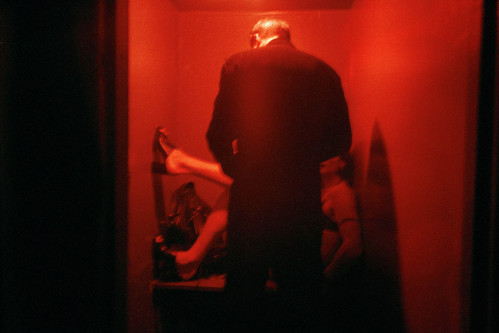
Jean Christian Bourcart, photography.
The scripts for 99% of Hollywood film and TV are written in ways that sustain the ideological backdrop of the system. There is no depth, and there is no history. There are only advertisements for the status quo. Dawn of the Planet of the Apes, the third or fourth (who’s counting) in this franchise, has effectively removed even the tiny bit of social criticism that existed in the original. It is also stunningly humorless (more on that in a second) and entirely mediated by CGI. That this digital soup is no longer read as such is perhaps the most depressing aspect of the entire experience. The ‘Apes’ speak a sort of inconsistent pigeon english, much like *natives* spoke in Ramar of the Jungle fifty years ago. The apes represent the masses; ignorant, easily led and manipulated…unlike the white heroes, the humans, those who *should* be leading. That the ‘bad’ ape is named Koba only reinforces a residue of old time anti communism.

Dawn of the Planet of the Apes, 2014. Matt Reeves, dr.
Real nature, is being destroyed. http://www.theguardian.com/environment/2012/sep/03/bernie-krause-natural-world-recordings

Miroslaw Balka, “How It Is” installation at Tate, London 2009
I suspect that Miroslaw Balka’s installation at the Tate Turbine Hall, a couple years back, was intuitively about the lost uncanny. That Balka is Polish Catholic makes sense. For guilt and atonement seem to somehow intrude on the mysteries of repression. The Balka piece is very effective. The Polish Catholic religion is punishing, it is dark, and while Spanish and Italian Catholicism is equally tortured, the northern Catholics tortured soul is one without color. At the top is a photo of Katie Paterson’s ‘Moonlight’ piece. Working with technicians and science geeks she commissioned a bulb that gave off the same light as moonlight. While close to a junior high school field trip to the science fair, where you see this at one of the booths, it is also curiously unsettling and sort of comforting, as well. And in that sense, it possesses it’s own sense of uncanny. I wanted to end with a comment about a film from Australia. Mystery Road. It is bone simple genre narrative (subtracted genre) about a returning indigenous cop, “abbo copper”, to the outback nowhere town in which he was raised. A teenage aboriginal girl is found beneath an overpass on the highway. The troubled cop goes looking for the killer. Race prevents anyone helping him. He overcomes problems. Its aboriginal noir, or High Noon in the outback. Somehow, however, it’s surprisingly poignant. In the same way The Hunter (2011, David Netheim dr.) managed something similar. The shadow of ethnic cleansing, of colonialism, of white settlers and violence hangs over the entire landscape. Aaron Pedersen is rather stunningly good as the indigenous policeman, too.
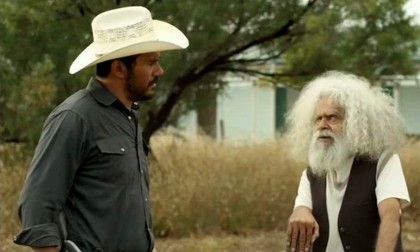
Mystery Road, (2013), Ivan Sen, dr.
If one watches enough network and studio material, it is hard not see the bankruptcy of real imagination, and not see the truly insane infantilism at work. First of all, a quick survey of exactly what is on TV is pretty telling. So called “Reality shows” dominate scheduling. A quick check of saturday nights revealed (my quick head count) twenty six reality shows. For Monday, I saw sixteen. That is a saturation level. That means the vast majority of air time is devoted to the most inane content free exercises in humiliation and cruelty. Of course these are also very cheap to make. So marketing will push them in all ways possible. But moving along to quality programming. One is given either the very crudest police state narratives, or military narratives, or comedies. That makes up roundly 80% of prime time. The prestige products though, in the end, are most telling. I wont burden you or myself with any detailed coverage here, but only to say the failure of narrative is connected to all the points above. Take HBO’s latest, The Leftovers, based on the Tom Perrota novel. Now Perotta is a Yale grad, erstwhile disciple of Tobias Wolfe, and later a prof at Harvard. The white elite. This is the MFA mafia from Ivy league programs. The show, roughly based on the book, is about the rapture…essentially. Its a very white rapture as God and HBO would have it. One of the creators is arch hack Peter Berg, a director with great ties to military Pentagon approved Imperialist war propaganda. There is no real story, beyond one day a lot of people disappear. There is a pseudo classical sound track, and a credit crawl replete with fake frescos. The entire first season, and yes I suffered through it, is about exactly fuck all nothing. There are plenty of homilies about family, and sentimental teary eyed remembrances of the departed, but in the end, this is perhaps the ultimate example of non narrative. There are odd behaviors, of course. A cult, dressed in white, whose program remains obscure. My guess is that somewhere in this was meant to be an examination of guilt and faith. *Faith* being a word I really really hate…but anyway; the problem is that not much feels at stake. The town cop has a dad in the loony bin. Ok. And…? So maybe down the road all this grand bathos is stitched together. The problem, the core problem is that none of it possesses an urgency, none of it is mysterious in the right way. The mystery of banality is not compelling. Why one’s fuel pump blew today, and not tomorrow, is not interesting. It blew..because of planned obsolescence. But that’s not a narrative. Investing the fuel pump failing today with some mystical significance is what you get in The Leftovers. There is no history evident, this is the post modern facsimile movie town. The landscape is generic, and even the few oddities are carefully cleansed of anything that might offend. There is a horrible creepy ur-whiteness to the whole thing. The narrative? It is nothing, but nothing decorated with self conscious seriousness and a not to subtle idealizing of white family life. Honestly, Walt Disney would love it. Jerry Fallwell would love it.

Michael Tsegaye, photography. ‘Ethiopia’.
“Style is the imprint of what we are on what we do.”
Rene Daumal
In the early 1800s, Calasso described the bourgeoisie as being sick with history. Some connection to the past, in the courts and among the intelligentsia had been lost. The literature of the French noble class was trivial, the language itself had lost it’s depth, no great works of art were being written. Today, there is this massive edifice of pop culture, and the society is sick with with a kind of intellectual starvation. That anyone can watch Dawn of the Planet of the Apes without feelings of revulsion is proof of some final stage of bourgeois sickness. I suspect it is deeper now, and the white supremacist feelings expressed in police action, in criminal courts and across the communities of poverty were at least once masked, mediated by some phantom adherence to vague moral beliefs. No such mask exists today. This is (to borrow from Adorno) a dis-enchanted land.Pockets of resistance exist. Collectives, and independent farms, and yet the environmental crisis cannot be halted. There are worker’s organizations, and left parties, but U.S. militarism, the Imperialist march to murder even more, has no rational basis any longer, even for them, also will not stop. The photo of Hillary hugging Kissinger may become an iconic image. The corruption of the flesh matches the corruption of the soul. But those pockets of resistance must start to build a culture, for they often lack, more than any other thing, imagination and aesthetic awareness. Those who are repulsed by the glut of Hollywood junk, often simply reject all culture along with the kitsch culture. It is rejected in toto. There is, even in such groups, the residue of science as the primary solution. Even in places rejecting technology, instrumental thinking prevails. There is, as Marx said, a progressive and a regressive side to everything. Some of the logic of resistance demands Enlightenment values as a corrective to new age sophistry. In other cases, there is a marked cultural deficit. It is the least recognized area of authoritarian colonizing.

Amazing post. I feel like you have broken new ground here — while every post on this blog attacks some central thesis from a different angle, I feel like many posts up till now have sort of “clustered” around a recurring set of concerns — but this one touches upon many things that you’ve not treated before. Or at least not in such detail. So, I’m going to need to digest it for a while.
But, honest question here: do you think humanity can escape this totalizing influence? Will we sink into another Dark Ages, except worse because it will not be only European (thank god that Islam and China existed during the Middle Ages), but a universal malaise? And once we sink, how long will we be mired there? How do we create a coherent resistant art, when we can only find coherence in the culture industry, while all resistant artistic communities are doomed to fracture? After all, a resistant artist can’t find their voice without the support of a sympathetic community, united in a sort of communion towards higher things; where are such communities to be found?
@exir:
i think what you ask dawned me during the writing of this. Dawned on me in the particular way you describe it. The mass totalizing, the hegemonic domination of the working classes and underclass, the increasing polarization of very rich and very poor…..that is clearly unstoppable. But the thing that frightens me is that as some new global dark age arrives, where will those Irish monks be….or where are those shunned strange desert Coptic communities preserving another way of thought and experience? I almost see some weird post modern monasticism taking place. Because when i see the left today, i see a handful of very smart people….activists, thinkers, and then I see an ocean of people calling themselves leftists who are not. Hipster anarchists, and trots, who I would rather go over to the scientologists than suffer rule by trotskyists…..and i see a huge chunk of this cool snarky white leftism. The only future is from the southern hemisphere. And thats possible. The new version of medieval china and islam is South America and maybe parts of south asia. Tiny chunks of scandinavia perhaps. But the south american socities now are the least corrupted it seems to me. They are least colonized by mass US culture, they are the least visited areas by western tourists, interestingly. And they had movements that gained traction….Cuba and Venezuela. And then Bolivia….and to a lesser degree Ecuador and Uruguay. But recently the Colorado party returned to power in paraguay after what was effectively a coup. Lugo was tossed out, and the interruption in the sixty year reign of Colorado was halted. Now bush and family own a jillion acres in paraguay. So this is interesting. The US has targeted south america. You can expect a concerted assault on that region soon. But….as long as the middle east and russia occupy the fascists, then perhaps they can survive. But the short answer is, I dont know, probably mankind cannot survive.
@Exir,
Lots to think about and my responses keep sort of slipping away from me and morphing into multiple interpretations. This process has made me question myself, which is a good thing, I think.
Exir said: “honest question here: do you think humanity can escape this totalizing influence?”
I suspect that our “humanity” (whatever is left of it), cannot be “totalized.” I wonder if that is a contradiction in terms…? I see “humanity” as a sort of quality that human beings may or may not nurture. I do happen to think there are a few old Irish monks lurking about the planet…
Exir continues: “How do we create a coherent resistant art, when we can only find coherence in the culture industry, while all resistant artistic communities are doomed to fracture?”
First off, I am not really sure what you mean about the culture industry being “coherent.” Secondly, If the art is resistant, it will be coherent, because the status-quo is inherently incoherent—ethically incoherent. If art is resistant, it will not fracture—-unless ‘fracturing’ is a quality, or a form, of that resistance. Sometimes you must break a bone in order to escape from the trap…
Exir continues: “After all, a resistant artist can’t find their voice without the support of a sympathetic community, united in a sort of communion towards higher things; where are such communities to be found?”
Does the artist ‘find their voice,’ or is the artist’s job really to Hear those Other Voices…? And, is it not the artist’s job to “find” the community? No one said it was going to be easy. It might be impossible, but the struggle to ‘make the impossible possible’ (as a dear mentor once told me), is–I might venture to suggest–both a source and a testament to our humanity.
Im just going to say a couple things calla. Im sure exir will answer you. But the idea finding a voice is one of those cliches people use almost out of necessity. But….per the community. There is a conflation with two different things. One is community, one is a movement……..artistically speaking. Most great art was part of a movement. It seems especially true in more collaborative arts like theatre. But its true in film, and its been true in painting. Community i always take as an audience in a sense, a critical one, and a support network. Artists need patrons. I mean jack nicholoson i remember giving away a ton of money to jim harrison, and buying the rights to all his books. But what I see today, is that even within the supposedly elite non commercial air of special institutions….the santa fe institute for example which has two writers…sam shepard and cormac mccarthy. Well, um, ok…..i like them both, but its curious I think. Or the Macarthur grant going to david simon. Does dave simon need that money? There are plenty of very good people who have worked outside the corridors of hollywood that could certainly fucking use that half million. So today the rot runs to the top, and commercial concerns outweigh all else. I remember other maccarthur winners in the arts that were seemingly very curious choices. But why wouldnt they be? Who is on that committee? This is the issue, that to find a point of view artistically that actually counters the prevailing ideological underpinning of mainstream culture is much needed and i dont see it. I dont. There are a few places in europe. Germany and france and beligum, and perhaps Italy in places…where radical work is being developed. In the netherlands, too and denmark. There are very radical political art minded groups and they have small but consistent audiences that support them. You rarely hear about that. I dont know of ANY in the US.
@ Steppling,
To be fair, I cannot easily deny that any of what you say is true.
Pointing out the difference between a “movement” and a “community” is helpful, because I think I was plainly thinking, “community.” And I guess, one person cannot really “move” on their own without that larger movement of engagement, otherwise that person is ignored, or their work becomes coercive or didactic. But where do “movement’s” come from anyway? (I guess that Exir was asking the same question).
Maybe most of us Are in the dark ages… I don’t know. I certainly won’t know if I choose to remain ignorant by believing that I understand. I mean, how did I form my understanding? From a great many questionable places, let me assure you. And I’m not sure that gaining knowledge or understanding is the hard part, I suspect it is the un-knowing that is much harder.
I guess it would be helpful to have half a million dollars to make art. But in our current economic/political climate, half a million dollars is a drop in the proverbial bucket that will evaporate before it even hits the bottom. I think the practice of making and receiving art is inherently democratic; therefore, dangerous to anyone rich enough in the United States to fund it. People that think, and people who invite others to think (or feel), are dangerous people. Dangerous to the rich who spend so much time elaborately covering their corruption, and relying on a belief in people’s intellectual impoverishment and fatigue to do so. I suppose that if people are so intellectually and emotionally bereft of any moral or aesthetic sensibility, then making art will always be like making art in/for a void.
Thanks, John, for bringing up the issue of economic patronage. I almost completely forgot it, but of course the economic structures supporting art does influence how art is produced in a huge way.
Regarding movement vs. communities: I think there’s a distinction to be made there — a “movement” is a group of artists with similar goals and ideals, while the “community” includes the audience. And I think speaking of movement without community is going to present a very incomplete picture, because the quality of the audience is almost more important than the quality of the artists in determining the quality of art. In a sense, it’s not the artist who makes art, it’s the audience.
I’d just like to use a few examples from the past. Shakespeare’s plays could not have existed without a huge cross-section of audience members that spanned across class lines and nationality. I think there were historical figures about Elizabethan theatre attendance that were just staggering — practically speaking, the whole urban community turned out. And these were profoundly literate people, not just due to the rise of literacy for commoners, but also more importantly because of the AURAL literacy of the population. A great demonstration is John Donne, who was contemporary: we have his published prose sermons, and we can see his long, involved, majestic periodic sentences. And we know that he would sermonize for hours and attract a huge crowd willing to stand in the nipping cold just to hear his sonorous voice. Now most of the crowd would have been illiterate, yet they could follow these periodic sentences for hours without faltering because they were raised in such an oral culture that they have developed aural literacy. THAT is the soil from which Shakespeare sprung. That is why his dramatic verse and prose would have been as vivid to the audience of his time as our cinema would have been to ours, because the audience then would have had the sensitivity to be instantly receptive to every nuance in his language. Of course, a popular myth that I hear from those who subconsciously are defending our pop-culture, who think Pixar is as deep as Shakespeare (your circle of acquaintances would doubtless be different, but I have a feeling you’d have heard similar things said, as these thoughts are definitely “in the air”, so to speak), is that “oh, look, but Shakespeare was thought to be trashy low-brow kitsch in his time, and it wasn’t much later that people realized how great he was; maybe our trashy Hollywood films would have the same fate!” Well, no. People often thought the THEATRE was trashy and sinful, or at least beneath respectable company, (although, like all cultural attitudes, they only seem so categorical and monolithic due to the distorting distance of history; if the Queen could turn out at the theatre, it can’t be considered THAT bad), but even they did not miss Shakespeare’s great literary talent. He was ranked with Seneca, Aristophanes and Dante while he was still alive!! So, he definitely had a receptive audience that nourished him and that he nourished in turn. And it CERTAINLY is not true that only the “educated” upper-class audience could have understood Shakespeare fully, so the whole argument that kitsch pop art as a recent phenomenon is caused by the rise of mass literacy, apart from being really classist and reactionary, is also just nonsense.
Similar things applied to the Greek tragedians: these performances were civic events that the whole community was expected to turn out to, certainly all citizens, but also (disputed) possibly slaves. And the speeches in those tragedies were living concerns to the people of that time; the etiquette of silence in the theatre was not established then, so while the characters were debating issues of morality and fate on stage, the audience would have certainly been just as lively among themselves, deciding issues of politics and citizenship.
One last example: the great Victorian novelists, Dickens, Eliot, et all, were read widely. They all had receptive audiences.
Maybe there are some counter-examples. Emily Dickinson, one of the greatest poets in English, (I think her achievement is underrated because nobody seems to notice that she’s the only great poet who wrote “aphoristic” poetry in English. Growing up with a Chinese and Iranian background as well, I am well-aware of how important aphoristic poetry is to both these cultures, and looking at English poetry, you can see prominent lyric, epic, dramatic, or didactic poetry, but *never* before Dickinson was there any aphoristic poetry of value. And nobody seems to have followed her lead… but I digress) secluded herself, and never had much of a receptive audience, since she wrote mostly for herself, MAYBE her family and friends, and being in a small provincial town her circle would have been painfully small, and you see this reflected in the almost suffocating claustrophobia of some of her poems. But even she needed her correspondence with literary men of her days. (This is well documented.) And her most productive and efflorescent period coincided with the few years where she was burning with the ambition to publish, and still had hopes that she could be published widely. When she buried that hope, her productivity dropped a great deal, and her poems never seemed to have the same urgency anymore. So, she may just be the exception that proves the rule.
—-
I stress all this about receptive audiences because I think we as a culture underestimate how important it is to have a community of audience with good taste and discernment. They nourish the artist, not just because the writer depends on their approval and patronage, but even on a psychic level: it FEELS different down to your bones whether someone is listening and getting what you’re saying, or whether nobody is listening.
So, what the heck, let me take the cliche of “finding my voice” a little further: I don’t want my voice to become hoarse and ragged due to the strain of shouting at a confused medley of noise, nor to become quiet and timid due to the shame and embarrassment of having my idealism viewed with suspicion, and still less to become bitter and tinged with a sickening inflection from speaking sarcastically to an audience that’s nodding out; I want to speak with a loud, clear, wholesome voice to people whom I respect and who respect me, as equals, partners in figuring out the mysteries of life. THAT is what I want.
—-
When I say that the mainstream popular art nowadays is “coherent”, I am not making a positive judgement of any sort, nor am I making a statement about how aligned it is with our humanity — I fully believe that a great deal of “misalignment” with human values can exist and yet still be “self-coherent”. The arts are full of contradiction, mysteries, what John calls again and again the uncanny (great word, that.) But there is none of that in Hollywood; it’s monolithic; and it’s, as far as possible, freed from all contradictions, because the logic of domination requires a totalizing unity. OF COURSE there will ALWAYS be contradictions, cracks in the facade, but now here’s where I sort of part with Marxist or Frankfurt School metaphysics: I don’t believe in the way they reify “dialectical” movement as if it was anything other than a model created by humans, a very useful model, but still reductive and falsifying. Things don’t “contradict” themselves and undergo “dialectical transformations” on their own, as if obeying the laws of physics, or the destined unfolding of a wound watch — there always needs to be an active human subject acting on it from outside, unearthing or even creating the contradictions. This applies to Hollywood too. But the totalizing influence is so pervasive — it seeps into so many aspects of life that previously were all apart, but now wrenched together under a “coherent” and monolithic ideology — that it’s become harder and harder to even find a place to stand on the Outside; it’s harder to find the fulcrum point from which we can leverage. Of course I’m speaking relatively; things are never fully accounted for by models or pictures, not even the picture I paint here — but I’m talking about a matter of extent, of how hard it has become.
With regards to the fracturing of the resistant communities, what I mean is that the coherent receptive communities of Shakespeare or the Tragedies does not exist. Shakespeare would not have been 1/10th as great if his audience was not a complete cross-section of the London world, if groundlings and aristocrats did not sit together in the same Globe. But our resistant art is of course divided into ever-atomising discrete “niches” of art, each of which don’t talk to the other, and each audience being an extremely narrow range. There’s art for intellectuals, art for punks, art for self-help-seekers, etc etc. And part of the fracturing is reflected in this critical dictum, (again, probably somethign you’ve heard often as it is “in the air”), where whenever you try to compare two pieces of art people would go “weeeeeeell… you can’t reeaally compare the two, they had such different aims and different contexts! they’re apples and oranges!” You wouldn’t believe how often I hear this, AGAIN AND AGAIN, from many different people, even artistically “educated” ones with “good taste” (which usually means they can see the point of view of everything and reject nothing, so whatever). IT JUST WON’T STOP. It’s uncanny, really, like someone programmed them to think this way. Well, OK, so you can’t compare Shakespeare with Steven Spielberg. Or you can’t compare Dante with Green Day. If we take that logic to its extreme, you can’t compare a song by Jay-Z with a song by Nicky Minaj, because sure, they both work in the genre of pop-rap, but they’re still facing a different audience because they’re in different sub-sub-sub-genres; or, actually, why don’t we say that even two different songs by the same artist is impossible to be compared critically, since technically these two songs would have differences in audience and context, no matter how slight. We might as well say that no piece of art can be compared with another piece of art! You see where I’m going with this, and yet people would absolutely believe in their “you can’t compare apples with oranges” without thinking through, at all, the reductio ad absurdum of what happens if we take their reasoning to its conclusion.
Art is a matter of atomized identity nowadays, in a way that distinguishes it from before. I’m not sure I can describe exactly how. Probably a comparative history of aesthetic communities is what is needed.
And about “Hearing Other Voices”, I agree with you wholeheartedly! I believe it is a writer’s job to enlarge their sympathy as widely as possible. Shakespeare was so great because he could speak in so many different voices as if they were his own. And that is just one more reason why a receptive audience is so important.
Exir:
I could be wrong, but what I sense you’re saying with your Shakespeare example is that great art should ideally be that which appeals to both “commoners” and the ‘cognoscenti’ in equal measure. If that’s the case, I’m inclined to agree. But I also feel that in the postmodern world in which we live, it’s far more difficult for an artist to achieve such a feat without compromising their integrity. For one thing, the nature of formal education has changed drastically in the last 150 years or so. But it’s worth asking what has caused this shift where artists now have a tendency to deliberately tailor their work to the tastes of a specific segment of society. For instance, Arcade Fire is deliberately tailored to the tastes of Williamsburg residents while Breaking Bad is tailored to the preferences of the average ‘college grad’. Haneke and Bela Tarr are begging for respect among “high brows”. And I don’t think we need to get started on the triad of Rushdie, McEwan, and Amis. There’s no sincere expression there. How did this atomization of culture come about and why is it that artists who transcend these boundaries tend to be rejected by certain segments of the intelligentsia? Stanley Kubrick seems to be a perfect example of someone who appeals to both the ‘masses’ and ‘cultured’ people in equal measure, yet he’s resented by large swaths of the intelligentsia due to this very fact. Likewise Fellini. Now I’d certainly argue Ozu and Bresson are superior to either of the former two, but I often wonder if the backlash towards people like Fellini, Kubrick, and Miles Davis, to name another one, exists for all the wrong reasons, since the active rejection of such “crossover’ figures seems to perpetuate such atomization. I guess I just feel a ‘gateway’ figure like Kubrick is a necessary stepping stone to being able to appreciate someone like Bresson or Ophuls, the latter of whom Kubrick considered the greatest of all filmmakers, and I’m almost inclined to agree with Stanley on that front, but that’s for another discussion.
How would you define art for intellectuals? Because I think for many people, Kafka, Joyce, and even Godard would qualify as ‘art for intellectuals’ just as The Clash is ‘art for punks’. But very few people with a modicum of self-respect I think would contest the ‘greatness’ of Godard or Kafka.
I think a lot of people forget that Straub and Huillet need Kubrick just as much as Miles Davis needs Andrew Hill even if they only serve to put each other into relief. Yes, I know I’m name dropping. 😉
@exir;
(and secondarily calla i guess)………..there is obviously a lot to say here, But let me start with audience. One needs a certain level of sophistication, if thats the word, to develop as a writer….or actor, or director. Im thinking theatre here. Without it, and today mostly one doesnt have it in the US….without it the playwright is at the mercy of either a few dedicated fans, a small elite audience, and that is not sustainable…OR….one begins to feel one’s throat clutched by the economic reality, and by theatre owners and artistic directors who themselves have their throats clutched….and there is built in tendency to write FOR the less educated audience out there (and for the artistic director or sponsors etc). Its a genuine problem. Sarah Shulman’s book Gentrification of the Mind touches on some of what happened in NYC…..with the gutting of the artistic community because of AIDS, the sudden take over of rent controlled buildings by real estate speculators etc. The disneyfication of the new york arts scene which had been radical for sixty years. Now in film say, there has always been, since its inception, an economic tension between filmmakers and studios. In europe it was a bit different, but film was largely seen as an amusement. Still, you need an audience. Today one hears things like “Shakespeare would have made a great screenwriter”. I think ben affleck said that. But this obviously begs bigger questions about arts education over all. Michael Silverblatt said to me once, after I asked him why his radio show had become so popular (the Book Worm) and he said it surprised him, but he decided that …knowing most of this audience didnt read, really….the popularity was people sub consciously recognizing the sound of wisdom, or deeper knowledge. And honestly, i think thats true. Sometimes one can see that, with certain work. But less and less. But there is a kind of primal desire for it, or need. And clearly this is the waning of modernism. The cult of the bourgeois artist, the genius, is dying. The problem is, great art works will continue to be produced, and are being produced, its just that how they are engaged with has changed. This is an era of shopping and fan-dom. In the future i expect as this fades, along with empire, there are going to be new oral traditions, and certainly an incorporation of this state of telecom hegemony is going to be the material that is used. But we are in some weird transitional stage. Don DiLillo is NOT the answer. Abramovic and various other samplers are not what is being searched for. But its slowly arriving. And yes, its likely to come out of non european places. From south america, and africa and south asia maybe. Russia …Iran …I dont know. But its going to draw upon a post empire experience, a post colonial experience I suspect. Right now, these places still imitate the voice of the colonizer to a large degree. The audience hasnt developed yet. But there are also issues with how I think technology survives. Someone on a social media thread today was asked about one state in the US deciding to reinstate penmanship as a compulsory class. People said, oh crazy. They should be taught computer science, how to write code. And i think learning to write code is fine…..but not as significant as penmanship. And this is because in some way one is creative and one is not. Also, I suspect technology is going to implode at some point as the inequality of the planet reaches fail safe. And you may be left with only stone tablets.
I know you didn’t technically address yous post to me, but if not DiLillo, what would be the answer? Is Pynchon the answer? Kiarostami? Or some whole other form of dissemination? Because I think that brings into question the issue of the tangible aesthetic object, whether that be a painting or a manuscript or even a film reel, and whether or not that has intrinsic value.
there is no answer. DiLillo isnt even the question. THATS the point I think. Give up these names, these rankings, these groupings. If I knew the future, I wouldnt have to pay atttention to the price of orange juice. Id own florida. I can only suggest that the DiLillo strategy of faux radical subject postioning (sigh) is just fraudulent. Or franzan…or any of these other litanies of shopping and commodities and brands. And its interesting i shall add, that the focus isnt on consumerism anymore in a sense. The problem of commodification remains, but that dynamic is morphing into a society in which you CANT get what you need, or even what you want, unless you are very rich…..but you must suffer the discourse that insists you can. And its why adorno is so crucial to read. And re read.
Thank you, Exir for your lengthy response. I am fairly familiar with the history of Elizabethan and ancient Greek theatre and the demographic make up of the audience, and yes, it seems as though such a dynamic would have allowed for a far more active relationship between art and community. I agree wholeheartedly also with what you say about the need for an audience. I too have observed this need, both making work and in being an audience member myself.
I remember one time I was at a ‘contemporary’ dance performance. It was a somewhat devised piece and it was about (or inspired by) the world wars. The piece was somewhere around 90 minutes in length. About thirty minutes into the performance I was just bored as hell, and feeling slightly guilty for being so bored and not trying hard enough to engage with the work, etc. Then I started thinking about my reaction and I asked myself, ‘why is it that I am so bored?’ ‘Why do I feel like leaving?’ ‘Why does this exercise seem so pointless to me?’ And I suddenly realized that I wasn’t needed. The dancers/artistic people putting on the show—they didn’t need me. The piece didn’t need me. My presence was superfluous. Like you say, Exir, the art needs its audience, it is completed in the audience. I think when art happens, it asks for something from the audience and it goes much deeper than it ever could without that presence of the other, actively creating the work on another level.
And, Exir, I think I see what you mean about “finding your voice.” I guess I realize it is a common cliché, but I haven’t had much use for it over the past few years because… well, I guess on one level, it didn’t seem to have room for a more dominant existential worry of mine: that I don’t have a voice… that I am empty, or that my voice is not my own. But I see the way you describe it, that “finding your voice” can still contain those existential dilemmas that I pose.
The problem for me might not be “finding my voice,” by finding the courage to dare to see the emptiness inside, and by finding the courage to face the horror of what I’ve done through filling this void with all sorts of other appropriated “voices” that might be hurting many people. I don’t know that courage simply comes from within, but having an “audience” or a community that creates a safe (another complicated word) place for me to search, is partly helpful, otherwise there is no mutual exploration of our common struggles. I think if I can respect the intelligence of my audience—or respect their ability to be personally affected and to be reflective—then my audience might let down their guard so that I may take that risk and go beyond what I think I know (and I don’t think that this is a cause and effect phenomenon–the vulnerability of the artist and the vulnerability of the receiver of the art creates, I think, a channel that flows both ways and is unpredictable). –Maybe, Exir, this is all just another way of saying what you wrote about not wanting your voice to become “hoarse and ragged” or “quiet and timid.” …Perhaps the “searching through for the emptiness” IS my voice. I suspect that artists do the searching when making the art, that the act of creating is, itself the search.
Blimey… I hope that made some sense. Lots to think about in what each of you wrote here, but I’ll keep my responses to these few points for now because I’ve digressed enough as it is and I feel I might have run full circle and maybe even an extra lap…
Your notion of “deep memory”…This touches, if I understand it correctly, on Socrates’ notion of all knowledge consisting of remembering. His pupil’s pupil, Aristotle, had a entirely different notion with the “tabula rasa”: minds born as a blank slate to be written upon. Somewhere between the two lies the truth. As a parent of three children I see how each one is born with a different and distinct personality (Socrates ?) yet develop according to their exposure to a different environment/stimuli (Aristotle).
Cultures that maintain their contact with the past have a better sense of “self” and the deep-memory is preserved as living-memory. With modern western culture, I think this link to the past is being supplanted with shallow mass/pop-culture with fabricated-links to the “past”. There is a purposeful revisionism occurring that fits their narrative: consumerism, profit, capitalism, etc. Those with a solid grounding in “deep memory” are less easily co-opted by mass culture. That is why there is a heavy attempt to destroy their history and replace it with something that fits with the current narrative. Once we’ve forgotten, we are doomed to live with the only narrative available.
Great posts (writing). They are very challenging for me and, thus, good (lucky if I comprehend 25% of those you reference/ideas discussed). Hope I’ve made sense here.
Calla, your responses have been very helpful. I’m not sure what I can add, other than the fact that it seems like we are all Moses — we all can never actually reach the Promised Land, but only see it from afar. I guess that is the writer’s task.
@robert………
Makes sense\ and I agree. I think this is one of the uncharted if not quite unintended consequences of advertising. I go back of course to Bernays and adam curtis Century of the Self documentary….a sort of seminal film actually in spite of how weird much of Curtis’ political thinking might be. Advertising quickly resulted the start of what is now a mass erosion of deep memory, supplanting it with these revisionist cliches. So i do think that cultures who continue to relate to their history, their ancient history even, are far less likely to suffer this sort of stultified and shallow notion of self, which is even worse than that I think. My next post will be about this, largely.
How does one manage to watch Dawn of the Planet of the Apes and believe you’re supposed to sympathize with the humans?